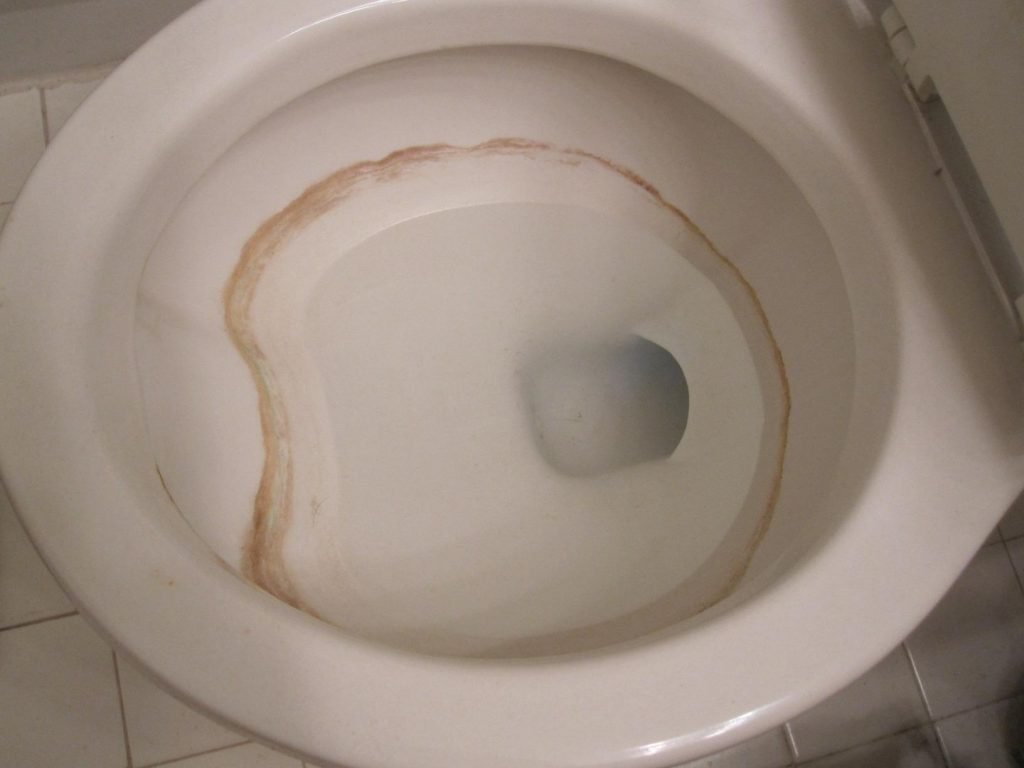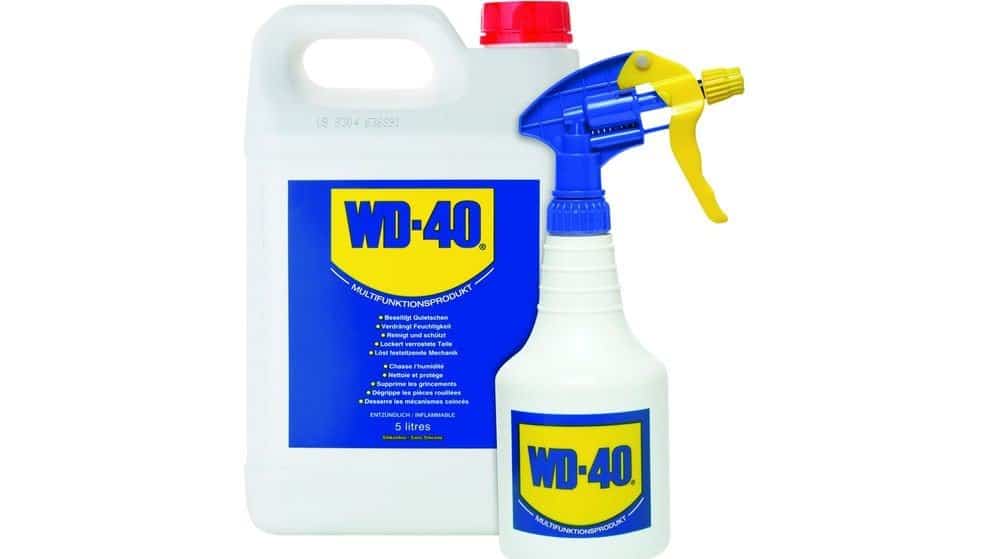WD-40 For Toilet – Cleaner For Hard Water Stains?
Last Updated on July 19, 2023 by toilethaven
WD-40 is not used as an everyday toilet cleaner; rather, it is used to remove stubborn hard water stains from a toilet bowl. It should be used as a last result after other ways of removing the stains have not borne fruit.
Most people see WD-40 as something that should be stored somewhere in a garage but not in the bathroom or kitchen. They are right, though. WD-40 is an excellent penetrating oil used to loosen tight connections and remove/prevent rust from parts.
Can You Use WD-40 to Clean Your Toilet?
Yes, WD-40 will remove the stubborn hard water stains/rings from a toilet bowl. Just spray a little bit around the affected area and wait 15 minutes. Scrub the bowl with a toilet brush to remove the stains. Wipe the WD-40 with a rag instead of flushing it down the toilet.
WD-40 is not eco-friendly and should not be used as a regular toilet bowl cleaner, especially if on a septic system, as it will kill the good bacteria in the septic tank. When used to remove hard water toilet stains, wipe them off from the bowl with a rag instead of flushing them.
I have written an article reviewing some of the best toilet bowl cleaners for people on a septic system. Read it here.
If you live in an area with hard water, you might have, without a doubt, noticed brown, black, yellow, or whitish/cloudy stains on your toilet bowl. If you removed the toilet tank lid, you would also see these stains.
What Causes Toilet Stains?

The brown toilet stains are caused by a high concentration of iron and manganese in the water. Iron, which is more notorious, reacts with oxygen to form iron oxide, which is commonly referred to as rust.
Black or green stains result from bacteria present in the water, while whitish/foggy/cloudy stains result from calcium deposits. These stains can make a toilet look way older than it is.
Hard water toilet stains appear anywhere inside the toilet bowl but are more likely to form a ring around the waterline at the bottom of the bowl. This is because the hard water is stagnant there and with a constant oxygen supply.
Although some toilet cleaners are advertised as capable of removing toilet stains in one go, the truth is that it is impossible to do that as long as hard water still flows into your toilet.
How to Remove Hard Water Stains in a Toilet Using WD-40
Most hard water stains in a toilet bowl are brown in color. This is caused by the high presence of iron and manganese in the water. White/cloudy stains are caused by calcium and indicate a high lime concentration in the water.
Whether your toilet’s hard water stains are caused by iron, manganese, or calcium, WD-40 will help you eliminate them.

- Remove the water at the bottom of the toilet bowl using a cup or a sponge.
- Spray the WD-40 on the toilet bowl targeting the stains.
- Give the WD-40 2 to 5 minutes to dissolve the stains.
- Use the toilet brush to scrub the toilet bowl, including the rim and the outlet.
- Flush the toilet to confirm that all stains are removed.
It is advised that you only use a small amount of WD-40 instead of pouring a large amount as you would do with vinegar. While shopping for the product, be sure to buy and use the low-odor type, leaving your bathroom smelling fresh.
Can WD-40 Unclog a Toilet
WD-40 will break down the clog into smaller pieces which can then flow down the drain easily hence unclogging the toilet. It is, however, not eco-friendly and should be avoided, especially for people on a septic system.
WD-40 will kill the good bacteria inside the septic tank meaning your waste will not be broken down faster than it should.
If you have a clogged toilet and don’t have a toilet plunger or snake, there are other safer methods you can use to unclog it. Read more about them in this post.
Other Ways to Remove Toilet Stains
Although WD-40 removes hard water stains from a toilet bowl, there are other ways that you should consider too. The most common toilet stain remover is a combination of vinegar and baking soda.
Pour a cup of vinegar into the toilet bowl and wait about one minute. Slowly add a cup of baking soda, followed by another cup of vinegar. Swish the solution around the toilet bowl after every 5 minutes for 30 minutes.
After 30 minutes, use the toilet brush to scrub the bowl targeting all stains until they are all removed. Flush the toilet and wash it with vinegar about once a week to prevent the stains from building up.
In case you need to remove a toilet ring, a pumice stone will come in handy. Drop it in the toilet bowl water for 15 minutes and let it soften. Pick one point of the toilet ring and rub it all around, being careful not to scratch the porcelain.
Other Ways to Use WD-40
Apart from removing hard water stains from a toilet, WD-40 has tens of other uses in and outside of the house. Let us look at some of them.
1. To Loosen Toilet Tank/Seat Bolts
Toilet tanks and toilet seats are mounted on the toilet bowl using bolts which sometimes are too tight and rusted and won’t just come off. Spray WD-40 and wait for about 15 minutes. WD-40, a penetrating oil, will make it easy for you to loosen the bolts.
2. Cleaning Tiles
WD-40 is an excellent product for removing stains from your bathroom tiles. Just spray it on the floor and walls focusing more on the edges and the base of the toilet, bathtub, and other fixtures. Give it five minutes, then wash thoroughly with a detergent.
3. Removing gum from surfaces.
If you have young kids around the house, then you know they always don’t dispose of gum appropriately. This gum dries against the wall, bed, floor, or any other part of the house. Spraying WD-40 on the dried gum will soften it and make it easy to remove.
4. Preserving tools
WD-40 is a great product that helps preserve tools by preventing rusting. In order for rusting to occur, there needs to be water, iron, and oxygen. The initials in WD-40 stands for Water Displacement. Before storing your tools away, spraying them with WD-40 displaces any water present and therefore protects them from rusting.
FAQs
1. Is it safe to use WD-40 in toilet cleaning?
WD-40 can be a great way of removing hard water stains from a toilet bowl. It is, however, not recommended as the go-to toilet cleaner. It would be best if you only used it to remove stubborn toilet stains and only spray a small amount on the toilet bowl.
2. Does WD-40 kill wasps?
Yes. A wasp is an insect that stings its prey and also humans. It likes to build nests in hidden edges or drill holes in wooden poles. Although there are other products that can kill them, WD-40 will definitely kill the wasps in your home or keep them at bay.
3. What do hotels use to clean glass shower doors?
Hotel glass shower doors are always looking spotless. To achieve this, mix vinegar and water in a ratio of 1:3 and put the solution in a clean spray bottle. Spray the solution on the inside and outside of the glass door and wait for about five minutes. Use a non-abrasive cloth and dish soap to scrub the door, then dry it completely.
4. Can I use WD-40 to clean my toilet tank if I have a septic system?
NO. WD-40 is not designed to be used as a conventional toilet cleaner. Better products include vinegar, baking soda, coke, pumice stone, etc. You only use it to remove hard water stains from a toilet bowl.
WD-40 is made of petroleum oil, which does not degrade and might find its way into someone’s drinking water or the ocean/lake. It also kills important bacteria found in the septic tank.
Although one use of WD-40 might not be very harmful, continuous usage should be avoided.